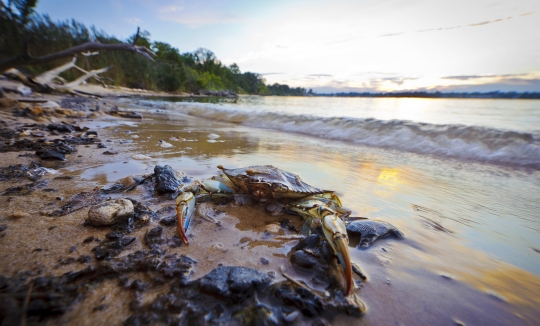 Maryland Blue Crab at Sunset on the Chesapeake Bay. Stock photo.
Maryland Blue Crab at Sunset on the Chesapeake Bay. Stock photo.Virginia, York River—We finished filming a movie about crabs the way we began it in the winter of 2015, with men and women of science on their hands and knees in oilskins on a cold, wet and wind-whipped boat deck, pawing through clumps of mud and shell and detritus dredged from the bay bottom.
They are divining the future, making sense of a mysterious world—an age-old quest that stretches from magic to science, from shamans poking at the entrails of sacrifices, to biologists sifting the guts of the bay for blue crabs down to the size of a fingernail clipping. It still starts with getting down and dirty.
The winter dredge survey we observed is in its third decade. Conducted throughout the Chesapeake by Maryland and Virginia, it counts blue crabs buried in the mud to predict how many will be available to harvest next summer.
Our Bay Journal film, "Beautiful Swimmers Revisited," covers the last 40 years since author William Warner's classic work on crabs, crabbers and the Chesapeake, "Beautiful Swimmers," was published. It includes two watermen who showed Warner a thing or two about crabbing in the 1970s and are still around to show us.
A real star of the film, which is turning out more optimistic (knock on wood) than I thought, is the winter dredge survey—or more broadly the ascendance of science in bringing the blue crab, our last great fishery, closer to sustainable management.
On this mid-January day the Research Vessel Bay Eagle, and its crew from the Virginia Institute of Marine Science (VIMS), are fishing with a 6-foot wide, steel-toothed dredge very similar to those used for decades by watermen in Virginia to haul in big, fat crabs by the barrel.
But the 65-foot Bay Eagle is sampling, not crabbing. A fine mesh liner in the dredge retains even the tiniest blue crab; and Cap. John Olney, Jr., only drags the bottom for 60 seconds at each station, just as his Maryland counterpart does in the Upper Chesapeake.
Nor is the VIMS crew interested in dredging where the most crabs are. They go to spots randomly selected by a computer. Looking where crabs usually aren't as well as where they usually are, makes the survey more sensitive to annual population fluctuations, the scientists explain.
The survey's other real strength is the long-term layering of year upon year of data, plucking trends and patterns from the inescapable 'noise' of nature—hurricanes, freeze-ups, explosions of crab predators—all of which can make any one year of little use in predicting how many crabs can be safely harvested.
The winter survey began coming into its own after about 10 years. Now, at age 25, it's mature and affords crab managers some of the best data of any such survey in the world upon which to base harvest limits.
It's not foolproof. In 2012, it predicted, accurately, lots of crabs; but something happened between winter and summer—maybe unusual numbers of crab-eating fish. Watermen and scientists alike were confounded.
Rattling loudly, a steel chain with links thick enough to fill your grasp, labors the heavy dredge aboard. "Woohoo! First female, a pretty lady," exclaims Dr. Romuald Lipcius, a VIMS crab researcher. It's a "sook", a female that has performed its once-in-a-lifetime mating and assumed the mature, "Capitol dome" shape on its abdomen.
Lipcius has been tagging mature females for more than a decade during the dredge survey, one of many side benefits of such long-term baywide monitoring.
Recovery of tagged crabs has given scientists their best answer to a seemingly simple question: How old can crabs get? (Answer: 6–7 years.)
Knowing a species' lifespan is key to conserving them. For example, female crabs can spawn two years in succession, but right now fishing pressure, combined with natural mortality, is such that 90 percent never survive to that point.
Doing the science gets you only so far unless you can act on it, which brings us to the politics of crab management, another star in the winter dredge survey's crown.
The late crab scientist, L. Eugene Cronin, spent his adult life teaching that crabs are a baywide species, best managed as a single stock; but that ecological truth long eluded politicians. The joint undertaking of the dredge survey helped pave the way for fuller bi-state cooperation.
As good a tool as the survey is, it won't always be. Water temperatures taken routinely by survey crews show that the bay is warming markedly as climate changes. The time is coming when Chesapeake crabs will no longer bury to escape the cold, and we'll have to find another way to count them.
Tom Horton has written about Chesapeake Bay for more than 40 years, including eight books. He lives in Salisbury, where he is also a professor of Environmental Studies at Salisbury University. Distributed by Bay Journal News Service.

